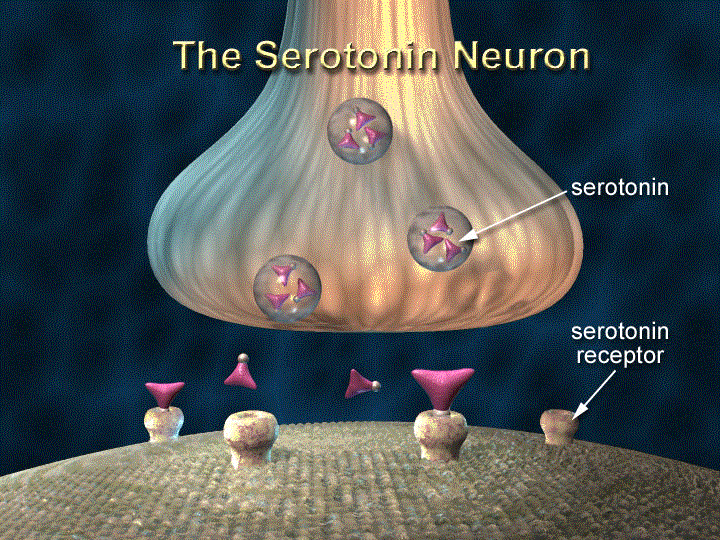Key Difference – SSRI vs SNRI
Selective Serotonin Reuptake Inhibitors (SSRI) and Serotonin Norepinephrine Reuptake Inhibitors (SNRI) are two antidepressant drugs prescribed as a medication for depression. Reuptake inhibitors prevent the reuptake of neurotransmitters by neuronal cells after a nerve impulse transmission. Neurotransmitters are secreted by the presynaptic knobs into the synapse to facilitate the nerve impulse transmission across to the post synaptic knob of the adjoining neuron. Thus, when the nerve impulse transmission is completed, the neuron will take up the excess neurotransmitters back to its cell, initiating the next nerve impulse transmission. Reuptake inhibitors block this process by blocking the receptors that are involved in the reuptake process, which results in the availability of neurotransmitters in the synapse, facilitating more effective nerve impulse transmission and acting as antidepressants. The key difference of SSRIs and SNRIs are based on the type of neurotransmitters they act on. SSRIs inhibit the reuptake of Serotonin whereas SNRIs inhibit the reuptake of both Serotonin and Norepinephrine.
CONTENTS
1. Overview and Key Difference
2. What is SSRI
3. What is SNRI
4. Similarities Between SSRI and SNRI
5. Side by Side Comparison – SSRI vs SNRI in Tabular Form
6. Summary
What are SSRIs?
Serotonin is a neurotransmitter that is mostly found in the digestive system. It also is considered as a potential mood stabilizer. Selective Serotonin Reuptake Inhibitors (SSRI) are also known as serotonin-specific reuptake inhibitors, or serotonergic antidepressants are a type of antidepressants that have a specific function of inhibiting serotonin reuptake by neurons and prevent the process of replacing the neurotransmitter. These inhibitors selectively identify the receptors which are involved in the reuptake of serotonin and block them. This results in increased availability of serotonin, and this serotonin helps in effective nerve impulse transmission to restore the chemical balance.

Figure 01: Serotonin as a Neurotransmitter
SSRIs should be administered as per the regulations of the doctor, and the recipient experiences positive changes after 4 to 6 weeks of treatment. Side effects of over dosage of SSRI are nausea, dizziness, uneasiness and fatigue and the dosage differ from person to person depending on the type of depression, severity, and other background health conditions. Approved SSRIs include Citalopram, Escitalopram, Fluoxetine, Fluvoxamine, Paroxetine, and Sertraline.
What are SNRIs?
Serotonin, as described above, is a mood stabilizer whereas norepinephrine, which is a neurotransmitter, is the main neurotransmitter used by the sympathetic nervous system. Norepinephrine generally activates the particular effector organ or muscle in response to a stimulus; this is often an energy consuming process which results in increased heart beat or increase in calorie burning rate. Serotonin Norepinephrine Reuptake Inhibitors or SNRIs block the receptors for both Serotonin and Norepinephrine, inhibiting the process of reuptake of these neurotransmitters. Thus, SNRIs are mainly effective in the treatment of long term depression and chronic pains.

Figure 02: SNRIs
Approved SNRIs include Duloxetine, Venlafaxine, Desvenlafaxine, and Levomilnacipran. The side effects of SNRIs mainly depend on the form of SNRI taken, and common symptoms include nausea, fatigue, and dizziness.
What are the Similarities Between SSRI and SNRI?
- SSRI and SNRI are reuptake inhibitors.
- Mechanism of action in both drugs is similar. They block the reuptake receptors in the neurons inhibiting the reuptake of neurotransmitters.
- Both types act only on neurotransmitters.
- Both drugs act as antidepressants.
- They act on presynaptic membrane receptors.
- Side effects are possible with both drugs upon unguided treatment procedures.
What is the Difference Between SSRI and SNRI?
SSRI vs SNRI | |
| SSRI is an antidepressant drug which blocks reuptake receptors of Serotonin in the presynaptic knobs. | SNRI is an antidepressant drug which blocks reuptake receptors of both Serotonin and Norepinephrine on the presynaptic membrane. |
| Type of Neurotransmitter | |
| SSRI acts only on serotonin. | SNRI acts on both serotonin and norepinephrine. |
| Specificity | |
| SSRIs are highly specific. | SNRIs are not highly specific as they have affinities towards both Serotonin and Norepinephrine |
| Selectivity | |
| SSRI only selects receptors responsible for Serotonin reuptake. | SNRI has the ability to select two types of receptors for Serotonin reuptake and Norepinephrine reuptake. |
| Introduction | |
| SSRI is a conventional antidepressant. | SNRI is a newly invented antidepressant. |
Summary – SSRI vs SNRI
SSRIs and SNRIs are popular antidepressants which can inhibit the reuptake process of neurotransmitters by receptors in the pre-synaptic membrane, thereby increasing the availability of neurotransmitters for effective nerve impulse transmission. SSRIs only blocks Serotonin receptors while SNRIs block both Serotonin and Norepinephrine receptors. This is the main difference between SSRI and SNRI.
Download PDF Version of SSRI vs SNRI
You can download PDF version of this article and use it for offline purposes as per citation note. Please download PDF version here Difference Between SSRI and SNRI.
Reference:
1. “Selective serotonin reuptake inhibitor.” Wikipedia. Wikimedia Foundation, 27 July 2017. Web. Available here. 02 Aug. 2017. .
2. “Selective serotonin reuptake inhibitors (SSRIs).” Mayo Clinic. Mayo Foundation for Medical Education and Research, 24 June 2016. Web. Available here. 02 Aug. 2017.
3. “Serotonin and norepinephrine reuptake inhibitors (SNRIs).” Mayo Clinic. Mayo Foundation for Medical Education and Research, 21 June 2016. Web. Available here. 02 Aug. 2017.
Image Courtesy:
1. “The Serotonin Neuron” By National Institute on Drug Abuse – (Public Domain) via Commons Wikimedia
2. “SynapseSchematic en” By Thomas Splettstoesser (www.scistyle.com) – Own work, CC BY-SA 4.0) via Commons Wikimedia
ncG1vNJzZmivp6x7pbXFn5yrnZ6YsqOx07CcnqZemLyue8OinZ%2Bdopq7pLGMm5ytr5Wau26%2F0qugZpmemXq3v4yspauhXw%3D%3D